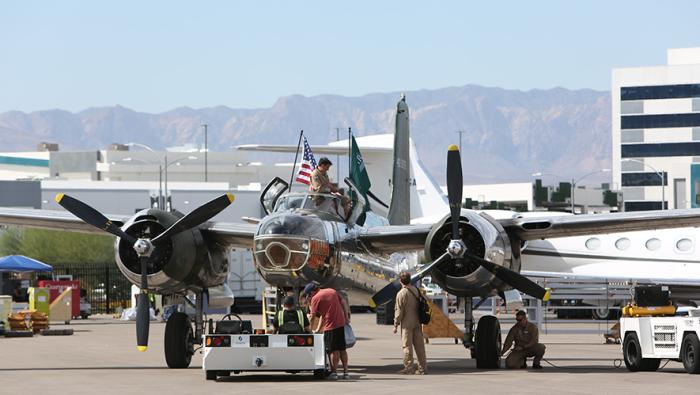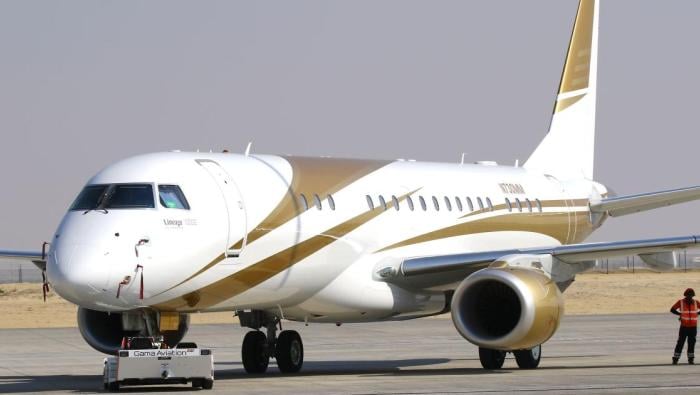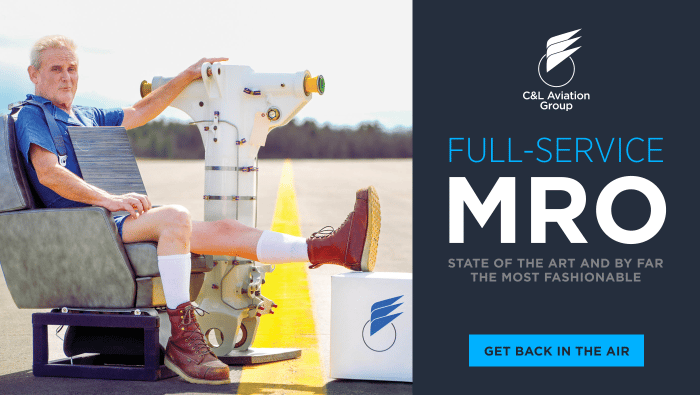|
Embraer this week reaffirmed that it is actively studying the case for entering the large-cabin business jet market. Speaking at its investors day event at the New York Stock Exchange, a leading consultant urged Embraer Executive Jets president and CEO Michael Amalfitano to confirm whether his group will step up to compete with Gulfstream, Bombardier, and Dassault, and he didn’t rule out the move. Dean Roberts, v-p for strategy, sustainability, and development with Rolland Vincent Associates, argued that the time is right for the Brazilian manufacturer to expand its portfolio beyond its Phenom and Praetor family of light and midsize jets. “You've got success,” he told Amalfitano. “There's plenty of growth in market share to keep going. But if you want to keep going long term, you're going to have to move into large aircraft. Large is the biggest value market. Large is the fastest growing market. “The incumbents have moved up to the top end of large with heavy, large expense machines that are suitable for the real top end,” he added. “But they've left a gap at the bottom…It’s a perfect space for an Embraer disruption.” While declining to rule out the move, or say when and how Embraer might take this step, Amalfitano said his company will take its time. Until 2020, the manufacturer produced the larger-cabin Lineage and Legacy 600/650 models. |
|
|
Runway excursions account for nearly one-third of all business aviation accidents—lately, these events are becoming all too common. Most troubling, barring a mechanical failure, these events are preventable when pilots understand the well-known risks and adopt best practices to mitigate these risks. According to the NBAA Safety Committee, runway excursions are a “towering concern” and have been cemented on its list of top safety focus areas for nearly a decade. The FAA, NTSB, Canada’s TSB, and other aviation agencies have all expressed concerns about runway safety, including runway excursions and incursions. I, too, am concerned. What is going on? Last month, I wrote about high-energy approaches after two business jets on one calendar day overran runways—only to be saved by EMAS. And one day before that blog was published, a Cessna Citation CJ4 overran a runway in Kentucky, broke through a fence, crossed a highway, and hit a house. Three weeks later, a CJ3 overran a runway—this time coming to rest on a golf course. Soon, I will write my 100th AINsight blog about safety events in business aviation, with an emphasis on reducing risk. Unfortunately, runway excursions happen all too frequently, and one-in-five of my blogs are related to reducing approach and landing accidents. Runway excursions are preventable; following SOPs makes sense, increasing the margin of safety and helping eliminate these accidents. |
|
|
The new Gulfstream Aerospace Texas Repair and Overhaul Center in the Dallas-Fort Worth area is officially open, adding more component repair and overhaul capabilities to the company’s service arm. Gulfstream's three-year-old factory-owned service center is nearby at Fort Worth Alliance Airport (KAFW). Gulfstream spent $21 million to build the facility, which encompasses 100,000 sq ft and houses more than $5 million of dedicated parts and inventory for repairs. Activities at the center include wheels, brakes, batteries, hydraulics, structures, and composites. Plans call to add avionics, landing gear, and other components to the menu. “By expanding our in-house repair and overhaul capabilities, we’re expediting turnaround times and increasing parts availability to best support our customers’ needs while maximizing safety, quality, and efficiency,” said Gulfstream president Mark Burns. “We will continue to invest in component repair, maintenance support, and spare parts to enhance overall service for our customers, particularly as our fleet continues to grow.” Earlier this year, Gulfstream opened an expanded service center in Mesa, Arizona. “I believe this [year] to be the single most significant investment in customer support in the history of our company,” said Lor Izzard, senior v-p of customer support. |
|
|
AMAC Aerospace is helping aircraft operators meet requirements to install Halon-free fire extinguishers to replace ozone-depleting equipment under international rules. On Monday, the Europe-based maintenance, repair, and overhaul (MRO) group announced that it now holds a supplemental type certificate for the installation process and is helping clients meet EASA’s deadline of Dec. 31, 2025. Under global environmental protection regulations, aviation authorities are phasing out Halon-based portable extinguishers that are used to protect cabin and crew compartments in aircraft. AMAC is conducting the work at its sites in Switzerland and France. AMAC says it is seeing growth in the number of pre-purchase inspections (PPIs) it is conducting for aircraft buyers and sellers. This week, the company reported that it is now offering these services at its headquarters in Basel, Switzerland, as well as at its Turkish bases in Bodrum and Istanbul. In addition, AMAC said it is the first MRO provider to complete a Ku-band Plane Simple installation on Boeing Business Jets, and has also fitted kits on Airbus, Bombardier, and Gulfstream aircraft. |
|
|
VoltAero is battling to keep its plans for a family of hybrid-electric aircraft alive as it urgently seeks additional investment in the face of French insolvency proceedings. The company this week confirmed that around €5 million ($5.8 million) in equity capital promised by France’s ACI Group is now stalled as that company faces its own funding crisis. Through a filing with the commercial court at La Rochelle in western France on October 7, VoltAero has initiated “a formal redress procedure” to address possible claims by creditors while it seeks to secure new funding. The company has indicated that it might expedite plans to establish a U.S.-based subsidiary, even though it has its headquarters in the Nouvelle-Aquitaine region where it employs 35 people. Speaking to AIN, VoltAero’s CEO and chief technology officer, Jean Botti, explained that he had expected ACI’s investment to be finalized in early September, only to learn through media reports on September 21 that it was in financial peril. The ACI Group itself entered court-led administrative proceedings on September 25. According to French publication l’informe, this was the result of ACI not receiving an €80 million ($93 million) investment from Fortuna Capital Holdings that had been announced in February. Neither Fortuna nor its shareholder Wilshire Capital Funding have responded to requests to comment from AIN. |
|
|
Boeing Business Jets has introduced a new way for customers to own VIP versions of the iconic 747 jumbo jet. On Tuesday, the airframer announced a new “turnkey service” option through which it will acquire pre-owned 747-8s and extensively customize their cabin interiors prior to delivery, with full support provided when they enter service. The 747-8 was the last version of the widebody airliner family and entered commercial service in 2012. For private operations, the BBJ version of the airframe offers almost 5,000 square feet of cabin space that Boeing is now offering to reconfigure to meet customer specifications under a single contract, avoiding the need to use a separate completions contractor. According to Boeing, the 747-8 VIP model can fly up to 75 passengers with a range of 8,500 nm. This would allow non-stop trips between city pairs including New York to Bangkok and Dubai to Los Angeles. Today, there are nearly 50 747-8s in service, including several used for business and government transportation. The 747-8 Intercontinental model incorporates new technology from Boeing’s in-production 787 Dreamliner aircraft, and so has a lower noise footprint, as well as reduced fuel consumption and operating costs to earlier members of the 747 family. |
|
|
West Star Aviation was designated as an authorized overhaul facility for Embraer Praetor and Legacy landing gear under a strategic partnership with Héroux-Devtek, the company announced this week during NBAA-BACE 2025. The designation covers the Legacy 450 and 500, as well as Praetor 500 and 600, building on West Star Aviation’s capabilities as an Embraer-authorized aircraft maintenance facility. “Adding landing gear capabilities to West Star’s in-house portfolio of services will…shorten the overall turnaround time and ensure an outstanding customer experience,” said Marc-Olivier Gagnon, v-p of engineering and product support for Héroux-Devtek. West Star brings a range of capabilities to support its latest designation, including collaborative training to ensure it meets Embraer’s specification and Héroux-Devtek’s standards, a cadmium plating line with a chemistry lab for precise corrosion treatment, and advanced paint removal and cleaning processes, among others. In a separate announcement, West Star highlighted the growth of its team and facilities. It previously announced plans to add 40,000 sq ft of hangar space and 38,000 sq ft for office and back shop needs at its Grand Junction, Colorado site, along with additional ramp space. In Chattanooga, Tennessee, West Star is planning a 120,000-sq-ft expansion. “However, what excites us even more than the physical expansion is the incredible talent we are bringing on board,” the company said, noting initiatives to bring customer-focused team members aboard and foster careers of existing staff. |
|
|
Steven DeGroff, president of DeGroff Aviation Technologies, has set out to eliminate the risk that comes when a pitot cover is accidentally left on during a flight. “Human error will never come to an end,” DeGroff said. “So we have to design systems with technology in place to prevent hazards within the system itself.” His company’s new heat-activated pitot cover does exactly that. Traditional covers can melt or destroy the heated pitot tubes if heat is activated while they’re still attached, leading to costly replacements and safety risks. Beyond the financial hit, the stakes can be fatal—he cited a Bombardier Challenger 300 incident in Connecticut a few years ago in which pitot covers left on the aircraft contributed to a rejected takeoff. And when the sensors weren’t properly reset before takeoff without the covers attached, subsequent in-flight oscillations injured and later killed a passenger. DeGroff’s invention integrates a small glass bulb—similar to those used in fire sprinkler systems—inside a clamshell-style pitot cover. “Within two to five minutes after power up, it gets hot enough where it expands and shatters,” he said. The mechanism causes the cover to spring open, freeing the pitot tube before any damage occurs. “Nothing has changed in pitot cover technology for more than 100 years,” DeGroff said. “This is the first fail-safe that keeps those covered-pitot events from happening.” |
|
|
Aviation Fabricators (AvFab) is expecting certification shortly for two seats designed specifically for special-mission King Airs to help reduce fatigue, stabilize posture, and increase occupant stability on long flight legs, the company said this week at NBAA-BACE 2025. It is rolling out the Guardian seat for intelligence, surveillance, and reconnaissance missions, and the Responder seat for medevac missions. “We found there was room for new ISR seating,” said AvFab co-founder Jeff Lowe. “We were hearing from customers and our market research department found that the lead time, the cost, and the support were of considerable concern in the ISR world for seating.” According to AvFab v-p Hayden Lowe, the Guardian is purpose-built for ISR operators who need to maintain focus during missions that last up to 14 hours. The Responder shares many of the same features as the Guardian seat, but it is tailored to the needs of air ambulance operators, with the ability to rotate towards patients. In development for 18 months, the seats will be produced under technical standard order C39. The first two are destined for medevac operators, with delivery tentatively slated for November, pending certification. |
|
|

Photo of the WeekA tribute to the old and new. At this year’s NBAA-BACE static display—dubbed Aircraft Connection—the association welcomed some unusual participants to the Tribute To Flight Pavilion, such as this shiny Douglas A26 owned by Million Air boss Roger Woolsey, two DC-3/C-47s, the only still-flying and former Brigitte Bardot-hauling Lear 23, an amazing de Havilland Mosquito, Lockheed P-38, and representing the modern aviation landscape, an aerobatic Game Aerospace GB1 Gamebird. A big thank you to talented AIN photographer and pilot Mariano Rosales! Keep them coming. If you’d like to submit an entry for Photo of the Week, email a high-resolution horizontal image (at least 2000 x 1200 pixels), along with your name, contact information, social media names, and info about it (including brief description, location, etc.) to photos@ainonline.com. Tail numbers can be removed upon request. Those submitting photos give AIN implied consent to publish them in its publications and social media channels. |
|
|
|
|
AINalerts News Tips/Feedback: News tips may be sent anonymously, but feedback must include name and contact info (we will withhold name on request). We reserve the right to edit correspondence for length, clarity, and grammar. Send feedback or news tips to AINalerts editor Chad Trautvetter. |
|
AINalerts is a publication of AIN Media Group, 214 Franklin Avenue, Midland Park, New Jersey. Copyright 2025. All rights reserved. Reproduction in whole or in part without permission is strictly prohibited. |






.gif)




-Oct-17-2025-03-51-04-7517-PM.jpg?upscale=true&width=1396&upscale=true&name=Aircraft%20Post%20Business%20Market%20Recap%20Banner%20(v3)-Oct-17-2025-03-51-04-7517-PM.jpg)





